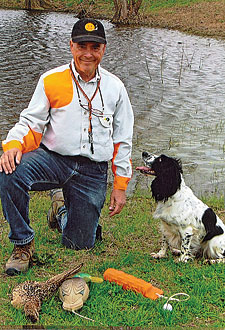The latest training techniques for spaniels.
By James B. Spencer
 This tip is from Buck Grabowski of Big Cocker Kennels, 13201 Jacobson Road, Lot 2, Manor, TX 78653; (512) 203-7322; Web site www.BigCockerKennels.com; e-mail bigcockerspaniel@aol.com. Buck has been training professionally for 10 years, specializing in training flushing spaniels for hunting, hunting tests and field trials. He participates in spaniel field trials, hunting tests, shooting dog tests and hunting. He judges spaniel field trials and hunting tests and breeds field-bred English cocker spaniels. |
"The only thing worse than hunting without a dog," Buck said, "is hunting with a dog that's out of control. Properly used, the e-collar gives you complete control of your dog in the field."
He stressed that to use the e-collar correctly, you should study all the available books, CDs and so forth on e-collar usage before strapping one on your spaniel for the first time. Then you should collar-condition him. Proper and complete collar-conditioning makes the e-collar both effective and humane. To make sure you do this important process correctly, seek the guidance of a good pro trainer.
Buck feels that variable intensity along with momentary and continuous stimulation are essential for your e-collar. Once you have established the proper stimulation level for your particular dog, you can use momentary stimulation in most situations and use continuous stimulation only when your dog seems to be insisting on a stronger reminder, like if he ignores your commands while chasing a crippled bird toward a road.
"If you're properly coordinated," he added, "and have enough time to introduce this feature, both you and your dog can benefit from a collar with the buzzer/beeper capability. Conditioning your dog to a sound immediately before stimulation will, in many cases, eliminate the need for stimulation. Your dog will learn to avoid the juice by reacting properly to the sound."
Buck recommends that while hunting, your spaniel should always wear his e-collar. However, he stressed that you should use it to reinforce only commands for which you have properly prepared him by collar-conditioning and reinforcement in training. By using your e-collar in hunting exactly as you do in training, you give your commands consistent, year-round authority. That way, you'll keep your dog from backsliding in his training during the fall.
"If you use the e-collar regularly during training, as you should," he said, "you can also use it regularly while hunting. Of course, you shouldn't get creative while hunting and spring something new on your dog. Just play it like you rehearsed it, maestro."
| Don't Miss More Tips | 

Find tips for your retriever here, and your pointer here.
|
|
Buck feels there are no hunting situations where you should not use the e-collar to reinforce commands on which you have properly prepared your spaniel. For example, even if he is out of sight, you can reinforce the "come" command.
Buck has found that the most common mistake hunters make with the e-collar is using it without first preparing with their spaniels. They have not collar-conditioned their dogs, or they have not used the e-collar properly in training--or both. If a dog hasn't been properly prepared for e-collar use while hunting, he won't understand why he's being punished. That, in itself, is abuse. When he doesn't react properly, his owner eventually becomes angry, which leads to more abuse.
"If you don't have the time or self-discipline to prepare your spaniel for e-collar use, don't use it, especially while hunting," he said. "Leave it in your car or, better yet, leave it at home."
E-collar abuse can lead to several problems. A spaniel that hasn't been properly prepared will associate stimulation with something, usually something in his immediate environment, and will thereafter avoid that something. Some spaniels, instead of flushing, will start pointing, which is undesirable in a spaniel.
Some will associate stimulation with birds so strongly that they start blinking (avoiding birds). Taken to the extreme, an e-collar-abused spaniel becomes what Buck calls a "boot licker." He is afraid to move out and hunt. Such a dog has learned to associate e-collar stimulation with the entire hunting environment.
"Maybe I'm repeating this message too often, but you should never use the e-collar while hunting unless you have properly and completely collar-conditioned your spaniel and then used the e-collar regularly in training," Buck added.
"If you skip either of those steps, your dog won't understand the messages you send him with the e-collar. If he doesn't understand, he'll misunderstand and do the wrong thing. That's how e-collar abuse begins. Collar responsibly."






